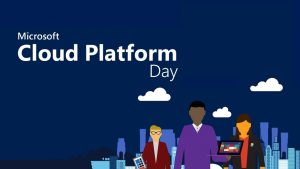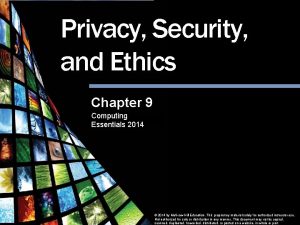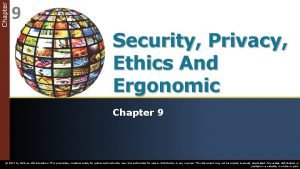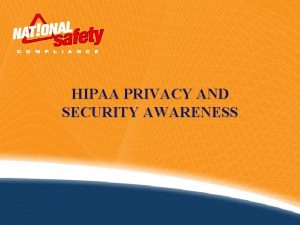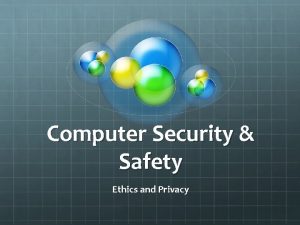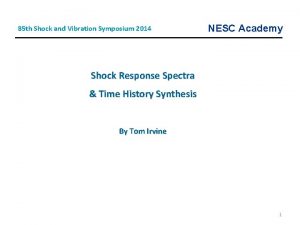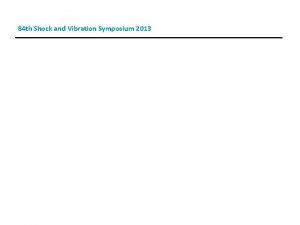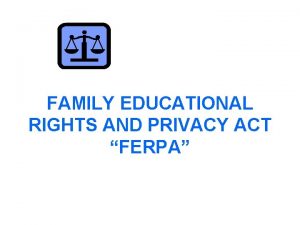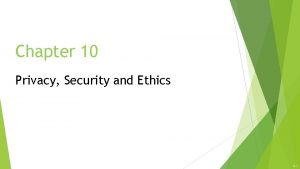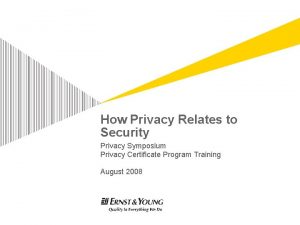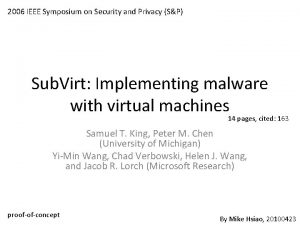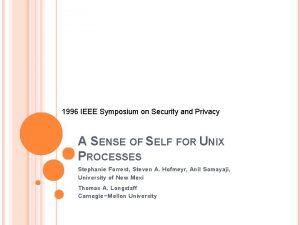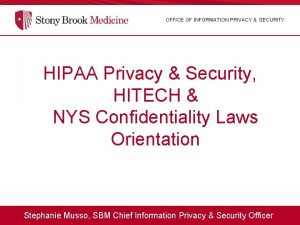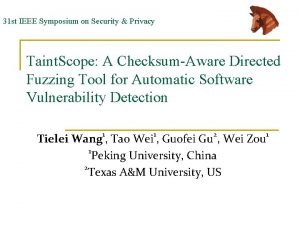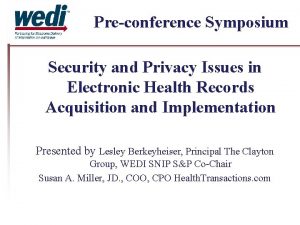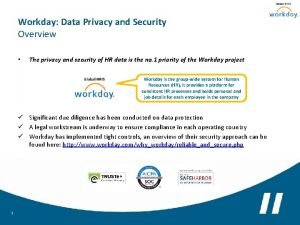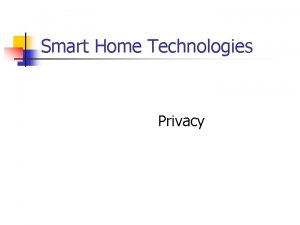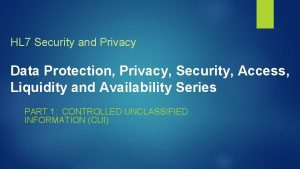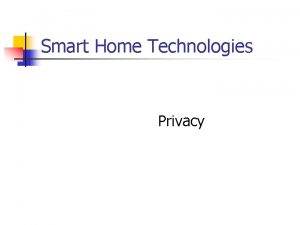2006 IEEE Symposium on Security and Privacy SP




















- Slides: 20

2006 IEEE Symposium on Security and Privacy (S&P) Sub. Virt: Implementing malware with virtual machines 14 pages, cited: 163 Samuel T. King, Peter M. Chen (University of Michigan) Yi-Min Wang, Chad Verbowski, Helen J. Wang, and Jacob R. Lorch (Microsoft Research) proof-of-concept By Mike Hsiao, 20100423

Outline • Introduction • Virtual machines • Virtual-machine based rootkit design and implementation • Evaluation • Defending against virtual-machine based rootkits • Related work • Conclusions 2

Introduction • New type of malware – Virtual-machine based rootkit (VMBR) installs a VM monitor underneath an existing operating system and hoists the original operating system into a virtual machine. • rootkit: tools used to hide malicious activities – VMBR are hard to detect and remove because their state cannot be accessed by software running in the target system. – Further, VMBRs support general-purpose malicious services by allowing such services to run in a separate operating system 3

Introduction (cont’d) • A major goal of malware writers is control. – Controlling the system allows malware to remain invisible by lying to or disabling intrusion detection software. – Lower layers can control upper layers. – If the defender’s security service occupies a lower layer than the malware, then that security service should be able to detect, contain, and remove the malware. • E. g. , ps, kernel-level rootkit, check the integrity of the kernel ds, hide/check memory footprint, 4

Virtual machines • A virtual-machine monitor (VMM) manages the resources of the underlying hardware and provides an abstraction of one or more virtual machines. – Multiplexing computer’s hardware – Isolate all resources of each virtual computer – VM services are implemented outside the guest they are serving in order to avoid perturbing the guest. 5

Virtual machines (cont’d) • VM services – debug operating systems and system configurations – migrate live machines – detect or prevent intrusions • Software running outside of a VM views low-level VM state such as disk blocks, network packets, and memory. • Software inside the VM interprets this state as high-level abstractions such as files, TCP connections, and variables. • It is called the semantic gap. Virtual-machine introspection (VMI) [18, 27] describes techniques that enables a VM service to understand modify states and events within the guest. [18] T. Garfinkel and M. Rosenblum, “A Virtual Machine Introspection Based Architecture for Intrusion Detection, ” in proc. NDSS, 2003. [27] A. Joshi, S. T. King, G. W. Dunlap, and P. M. Chen, “Detecting past and present intrusions 6 through vulnerability-specific predicates, ” in proc. SOSP, 2005.

Virtual-machine based rootkit design and implementation • 3. 1 describes how a VMBR is installed on an existing system. • 3. 2 describes the techniques VMBRs use to implement malicious services, and • 3. 3 discusses the example malicious services we implemented. • 3. 4 explains how VMBRs maintain control over the system. • They implemented two proof-of-concept VMBRs for the x 86 platform using Virtual PC and VMware Workstation VMMs. – The Virtual PC VMBR uses a minimized version of Windows XP for the host OS and the VMware VMBR uses Gentoo Linux. – They modify the host Windows XP kernel, Virtual PC, and the host Linux kernel. (They don’t have VMware source code. ) 7

Installation • To insert itself beneath an existing system, a VMBR manipulate the system boot sequence to ensure that the VMBR loads before the target OS. – After the VMBR loads, it boots the target OS using the VMM. As a result, the target OS runs normally, but the VMBR sits silently beneath it. 8

Installation (cont’d) BIOS Master boot record Boot sector OS Original Boot sequence BIOS VMBR loads BIOS Master boot record Boot sector OS Modified Boot sequence 9

Installation (cont’d) • To install a VMBR on a computer, an attacker must first gain access to the system with sufficient privileges to modify the system boot sequence. – exploit a remote vulnerability – fool a user into installing malicious software – bribe an OEM or vendor – corrupt a bootable CDROM or DVD image on P 2 P • Install the VMBR’s state on persistent storage – unused blocks elsewhere on the disk (Windows) – Disable swapping and use the swap partition (Linux) 10

Installation (cont’d) • Modify the system’s boot sequence to ensure our VMBR loads before the target OS – modify the boot records on the primary hard disk – But, anti-malware applications detect modifications to the hard disk’s boot blocks. – But, the author manipulate the boot blocks during the final stages of shutdown (after most processes and kernel subsystems have exited). • Windows XP: registers a Last. Chance. Shutdown Notification event handler – They use the low-level disk driver to copy our VMBR boot code (to bypass the file system layer). • Linux: modify the boot sequence using user-mode code – They modify the shutdown scripts so that our installation code runs after all processes have been killed but before the system shuts down. 11

Malicious services • VMBRs use a separate attack OS to deploy malware that is invisible from the perspective of the target OS but is still easy to implement. • Three categories (malicious services) – those that need not interact with the target system at all • E. g. , spam relays, DDo. S zombies, phishing web servers – those that observe information about the target system • VMBRs can use virtual-machine introspection to help observe and understand the software-level abstractions in the target OS and applications. • Not affect the virtual devices presented to the target OS. • E. g. , VMBRs enable logging of hardware-level data (e. g. , keystrokes, packets) • E. g. , if a target application uses an encrypted socket, attackers can use virtualmachine introspection to trap all SSL socket write calls and log the clear-text data before it is encrypted. – those that intentionally perturb the execution of the target system • The third class of malicious service deliberately modifies the execution of the target system. • A VMBR can customize the VMM’s device emulation layer to modify hardware -level data. 12

Example malicious services • The author implemented – a phishing web server, • in another VM – a keystroke logger, • in the VMM keyboard control module – a service that scans the target file system looking for sensitive files, and • use VM introspection to scan the target OS’s file system to copy the password file – a defense countermeasure that defeats a current virtual-machine detector. • redpill [39] J. Rutkowska. Red Pill. . . or how to detect VMM using (almost) one CPU instruction, 2005. 13 http: //invisiblethings. org/papers/redpill. html.

Maintaining control • To avoid being removed, a VMBR must protect its state by maintaining control of the system. – The only time the VMBR loses control of the system is in the period of time after the system powers up until the VMBR starts. • The first code is BIOS. – By restarting the virtual hardware, VMBRs provide the illusion of resetting the underlying physical hardware without relinquishing control. – VMBRs can also emulate system shutdowns such that the system appears to shutdown, but the VMBR remains running on the system. • We use ACPI sleep states to emulate system shutdowns and to avoid system power-downs. • When the user “powers-up” the system by pressing the power button the VMBR resumes. (powers-off only suspends the VMBR) 14

Evaluation • VMware-based VMBR – Run on a Dell Optiplex Workstation with a 2. 8 GHz Pentium 4 and 1 GB of RAM – compromises a Red. Hat Enterprise Linux 4 target system – VMBR image 228/95 MB (un-/uncompressed) • Virtual PC-based VMBR – a Compaq Deskpro EN with a 1 GHz Pentium 4 and 256 MB of RAM – compromises a Windows XP target system – VMBR image 251/106 MB (un-/uncompressed) 15

Evaluation – installation/boot time (sec) Actual memory usage is 3% for the extra VMM. 16

Defending against virtual-machine based rootkits • Security software below the VMBR – Such detection software can read physical memory or disk and look for signatures or anomalies that indicate the presence of a VMBR. – Other low-level techniques such as secure boot can ensure the integrity of the boot sequence and prevent a VMBR from gaining control before the target OS. • Intel’s La. Grande [25], AMD’s platform for trustworthy computing [2], and Copilot [36]. – Boot from a safe medium such as a CD-ROM, USB drive or network boot server – Use a secure VMM [17] (Terra) • does not by itself stop a VMBR, but does retain control over the system 17

Defending against virtual-machine based rootkits (cont’d) • Security software above the VMBR – (CPU overhead) by comparing the running time of benchmarks against wall-clock time – (memory and disk space) extra paging activity may increase the running time of the program – (I/O devices) VMMs only emulate a small number of virtual devices (often with customized interfaces to improve performance) – (x 86 processor features) sidt 18

Related work • Layer-below attacks – operating system kernel • Using virtual machines to enhance security – – VMs to detect intrusions, analyze intrusions isolate services encrypt network traffic implement honeypots • Detect the presence of VMMs • Inserting new software layers into existing systems – A key feature of all these applications is that they preserve compatibility with existing systems by not modifying interfaces of the existing layers. – E. g. , file system, firewall 19

Comments • Considering the characteristics of VM in security issues. – VMM layer – VM Image can be ”power on/off” • Some people don’t like VM environment. – How to detect that I’m in a VM? – How do I know my host/VMM/VM/OS is secure? – Can other vulnerable or hostile VM penetrate my VM? • Auditing mechanisms (such as VMMs) are benefits or harms for me? • Provide better visibility! 20
 Cvs privacy awareness and hipaa privacy training
Cvs privacy awareness and hipaa privacy training Microsoft from back doors gov active
Microsoft from back doors gov active Chapter 9 privacy security and ethics
Chapter 9 privacy security and ethics Chapter 9 privacy security and ethics
Chapter 9 privacy security and ethics Chapter 9 privacy security and ethics
Chapter 9 privacy security and ethics Hipaa privacy and security awareness training
Hipaa privacy and security awareness training Computer security safety ethics and privacy
Computer security safety ethics and privacy Provate security
Provate security Wireless security in cryptography and network security
Wireless security in cryptography and network security E commerce security meaning
E commerce security meaning Importance of symposium in education
Importance of symposium in education Shock and vibration symposium
Shock and vibration symposium Navmat p-9492
Navmat p-9492 Privacy and dignity in care
Privacy and dignity in care Ferpa law
Ferpa law Family educational rights and privacy act of 1974
Family educational rights and privacy act of 1974 Confidentiality and privacy controls
Confidentiality and privacy controls Three primary privacy issues are accuracy property and
Three primary privacy issues are accuracy property and Osi architecture in network security
Osi architecture in network security Guide to network security
Guide to network security Visa international security model
Visa international security model

